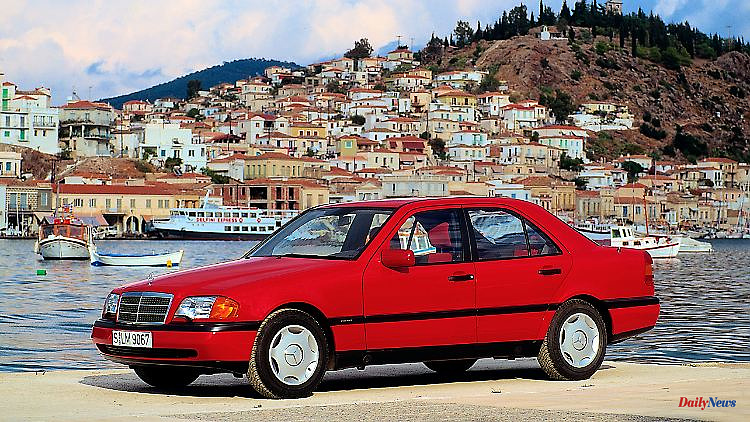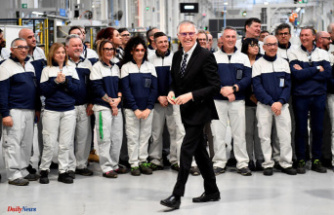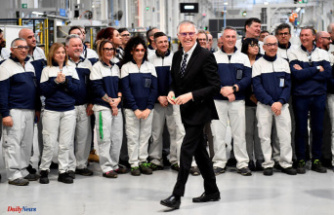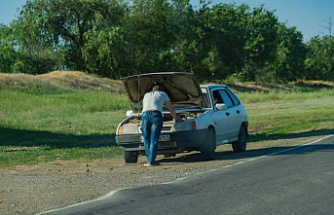With the Type 190 aka "Baby-Benz", Mercedes expanded its model range downwards. But it was only with the slightly larger C-Class from 1993 and the AMG models that the car manufacturer finally established a fixed star for premium and prestige in the middle class. The 30th birthday of the C-Class is now being celebrated in style.
The wall between East and West was gone, the European Union was founded, some fashion-conscious men suddenly wore kajal, girlie culture became a mass movement - and the conservative Mercedes brand became cool. In 1993 disruptive changes were due and the first Mercedes-Benz C-Class (W 202) reflected this reorientation.
The predecessor model 190, popularly known as "Baby Benz", had already established the brand with the star in the dynamic middle class, i.e. where the BMW 3 Series or Audi 80 (quattro) had been in charge until then. But with the C-Class, Mercedes went one step further: Together with the tuner AMG, high-performance athletes developed V8 engines as in the state-supporting S-Class and four-cylinders with powerful Roots compressors as a reminiscence of the furious "Roaring Twenties" with compressor racing cars . So much sportiness in the middle class even surprised the experts.
However, Mercedes couldn't help it, because dark clouds had been gathering over the Stuttgarter Stern since the late 1980s. In 1992, BMW sold more cars than Daimler-Benz AG for the first time, which even had to cut jobs for the first time in 30 years. A new nomenclature structured according to "classes" based on the model of the S-class launched in 1972 and the C-class as the first vehicle family based on this type pattern should now fix it.
The headlines in the business press about Mercedes, the passenger car division of the Daimler-Benz technology group, read dramatically at the beginning of 1993, with "even higher losses than expected" and "miserable sales expectations" written about. However, the media had underestimated the success of the new C-Class because of "bad years for Mercedes". With the four-door W 202 sedan and the station wagon (S 202) that followed in 1996, Mercedes launched a fixed star in the middle class that set standards up until the turn of the millennium.
None of the many new premium competitors from other nations could score points against the Swabian career type, the C-Class remained the bestseller with 1.85 million units in just over seven years. A number for which the predecessor Mercedes 190 needed three years longer.
What's more, as early as 1993, the C-Class put Mercedes-Benz back in pole position in the German premium production ranking and was even able to compensate for the decline in the aging E-Class (W 124) and the S-Class (W 140). In fact, the representative design language of the C-Class, designed by star designer Bruno Sacco, was also based on the S-Class that had been introduced shortly before.
The 202 series hit the nerve of the hedonistic society of the 1990s far better than the ambitious character types from Alfa (156), Jaguar (S-Type), Lancia (Lybra), Lexus (IS), Rover (75), Saab (9 -3) or Volvo (850). The charismatic Mercedes in the character of the C - the letter stood for "compact" and the type number from C 180 to C 55 for the cubic capacity - was able to assert itself surprisingly well against the cheaper Audi A4 and the BMW 3 Series, which was sold in many body variants.
The development of the 202 series began in the mid-1980s, when the Mercedes 190 mutated from a shooting star to a long-running hit and buyers of some models were still begging for a copy in the trade. Yes, something like that actually existed, even surcharges for allocation-ready purchase contracts were demanded in the classifieds section of the newspapers - for example for racers like the 190 E 2.3-16. Role models that the C-Class followed with various AMG versions.
The development team for the future C-Class asked themselves how this flame of enthusiasm could be carried into the future. Because the car gradually no longer documented a hierarchical position in society.
The European yuppies of the late 1980s rejected the prestige and ostentation of large, heavy bodies, and individual equipment was in demand instead. Just as diets from FdH to Atkins to Low Fat developed into philosophies back then, aerodynamic lightweight constructions boomed in the automotive world.
That is why heavyweights like the S-Class (W 140), which was state-supported under Chancellor Helmut Kohl, were criticized in Germany as too plump, but the C-Class with body shaping by Bruno Sacco was considered an eye-catcher. Four different design and equipment lines contributed to this: Classic, Esprit, Elegance and Sport set individual accents, and there was also an AMG styling package.
Today there are such differentiations even for inexpensive small cars, but back then so much individualism was a novelty - especially for a conservative brand like Mercedes. The first station wagon of the C-Class launched in 1996 also benefited from this customization program and also succeeded as an exemplary, spacious lifestyle truck with up to 1510 liters of storage space.
The technology highlights included new safety features - the C-Class tried to catch up with the Volvo 850 - such as standard driver airbags, side impact protection, ABS and later also sidebags, belt force limiters and the BAS electronic brake assistant.
The range of engines in the compact Mercedes was a real sensation: in 1995, the diesel fraction was delighted with the C 250, the first German turbo diesel passenger car with four-valve technology and intercooling and 110 kW/150 hp for sporty driving performance, before two years later the 92 kW/125 hp C 220 CDI introduced the smooth-running and efficient common-rail technology to German car production.
Fully electric C-Class models also pointed far into the future, although, as with the 190 model, they were only used as test vehicles.
Not only tuners like Brabus had a wild beast (300 kW/408 hp in the C V8) ready for all performance fetishists. Mercedes agreed to cooperate with AMG in 1990 and three years later presented the visually unobtrusive C 36 AMG as the first result. A wolf in sheep's clothing with a 3.6-liter straight-six and an output of 206 kW/280 hp - more power than a Porsche 911 Carrera provided.
Just one year later, the AMG C-Class with a 294 kW/400 hp 4.2-liter V8 dominated the German Touring Car Championship (DTM) - after Alfa Romeo had overthrown the Mercedes 190 from the champion's throne in 1993. And in Formula 1, a C 36 AMG was used as a safety car from 1996.
Racing fascination, which Mercedes celebrated with special models - and in 1997 with the C 43 AMG led to the provisional zenith. Because this bolide raged around corners and over the left lane with a V8 releasing 225 kW/306 hp until it was surpassed just a year later by the C 55 AMG.
Middle class is not mediocre at Mercedes, but always a bit of an S-class, as the first C-class made clear. No wonder that the V8 versions are particularly popular on the classic scene today.
Chronicle
1982: The Mercedes-Benz 190 (W 201) sedan designed by Bruno Sacco is presented in December. This is the third Mercedes series below the 200 D to 280 E series (W 123). With this first step towards an expansion of the series, the 190 model points to the future of Mercedes-Benz, which will be determined by a greater variety of models. The independent multi-link rear axle, which guides each rear wheel on five independent links, was specially designed for the W 201
1983: Market launch at the beginning of the year with the 190 and 190 E models with 2.0-liter four-cylinder petrol engines with 90 hp and 122 hp respectively, followed by diesel and six-cylinder engines later
1986: The development of a successor to the Mercedes 190 begins in the late year, two years later design concepts for this future C-Class (W 202) are created
1988: First major facelift for the Mercedes 190. The new top model is the 190 E 2.5-16 with 195 hp, in further evolutionary stages it later achieves up to 235 hp. This type also served as the basis for motorsport vehicles with which Mercedes-Benz achieved success, right up to winning the German Touring Car Championship (DTM) title in 1992
1990: The design of the future C-Class - developed under the direction of Bruno Sacco - is adopted and a patent applied for
1993: In January, Mercedes-Benz informed the press about a new product strategy and the division of products into the C-Class, E-Class, S-Class, G-Class and SL-Class. After the start of the pre-series at the beginning of the year, Mercedes-Benz presented the C-Class of the 202 series as the successor to the 190 (W 201) model as part of a new nomenclature on May 10. In September, the AMG version of the C-Class (C 36 AMG) with an output of 206 kW/280 hp made its debut at the IAA in Frankfurt, this being the first joint project between Mercedes-Benz and the AMG engineering office founded in 1967. Later, tuners also launched variants of the C-Class, such as the Brabus C V8 with an output of 300 kW/408 hp. A total of 5221 units of the C 36 AMG were built up to 1997. With the four independent design and equipment lines Classic, Esprit, Elegance and Avantgarde, the new Mercedes sedan is pursuing a new product philosophy that is intended to reach different customer groups. Driver airbag, side impact protection, power steering, ABS and central locking are among the standard equipment that has now been expanded. Production of the Mercedes 190 in the Sindelfingen and Bremen plants comes to an end after 1,879,630 vehicles, making the W 201 series one of the most successful of the Stuttgart brand. Mercedes produces 163,619 units of the C-Class in the first year
1994: The C-Class AMG is the winning vehicle in the German Touring Car Championship (DTM) under Klaus Ludwig and in the following year under Bernd Schneider. The racing touring car is powered by a 294 kW/400 hp 4.2-liter V8 derived from the S-Class engine (W 140 series). The C-Class special model DTM Edition is launched. Mercedes delivered 314,669 units of the C-Class, putting Mercedes-Benz back ahead of BMW (573,080 units) in the production ranking with 590,060 units. In the middle class, the Mercedes C-Class is ahead of the Audi 80/A4 (221,195 units) but behind the BMW 3 Series (389,808 units)
1995: In February, Mercedes delivers the 500,000th C-Class (202 series). With a Roots supercharger in the C 230 compressor (142 kW/193 hp output), Mercedes is bringing the era of supercharged models from the 1920s and 1930s into the present. The C 250 Turbodiesel makes its debut as the first turbodiesel car with four-valve technology and intercooling. A facelift in September brings, among other things, new upholstery covers, new cockpit elements (rounded switches, new heating and air conditioning controls) as well as grey-red rear lights and white indicator lenses. In line with the sponsorship of the ATP Tour, Mercedes is launching a special ATP C-Class model. Mercedes is testing the battery-electric drive with C-Class sedans. Mercedes delivers 302,115 C-Class units
1996: Body diversity in the C-Class begins with the station wagon (S 202). The loading artist is built together with the limousine in the Bremen plant. Also new are the standardized and modified four-cylinder petrol engines with a hot-film air-mass meter (HFM system) for the injection system. In addition, there is now a five-speed automatic with electronic control in the options program for the C-Class instead of the previous four-speed automatic. The C-Class becomes the official safety car in Formula 1
1997: For the 1997 facelift, the C-Class received redesigned bumpers, side skirts painted in body color, tinted rear lights, a slightly modified radiator grille, new door panels and seat covers. There are also standard sidebags at the front, performance belt tensioners with belt force limiters at the front and the BAS electronic brake assistant. V8 engine (90 degree cylinder bank angle) in the C-Class in the 225 kW/306 hp C 43 AMG. ESP is optional equipment in V6 models, standard from 1999. The 92 kW/125 hp C 220 CDI makes its debut as the first Mercedes diesel direct injection engine and the first German diesel with common rail technology. Mercedes produces 273,585 C-Class units, making the C-Class the brand's most successful model
1998: The new top performer is the C 55 AMG with 255 kW/347 hp from a 5.5-liter V8 (0-100 km/h in 5.5 seconds). Also new is the C-Class special model Champion. Mercedes still produces 254,943 C-Class units
2000: change of generations; The C-Class 202 series, of which more than 1.8 million units were built, is followed by the new 203 series, which is also available as a sports coupé for the first time and sets design accents with a "four-eyes face".
2001: The previous station wagon (S 202) is removed from the range in January
2021: Debut for the fifth C-Class (206 series) since 1993, this will be presented as a sedan and estate wagon, at the end of April a long version of the sedan will be added for the Chinese market
2023: The first Mercedes-Benz C-Class (202 series) celebrates its 30th birthday with numerous events, including classic car fairs in Bremen (Classic Motorshow) and Essen (Techno Classica). In addition, an H license plate can now be applied for for the oldest C-Class vehicles. The C-Class is a sought-after classic model, especially in AMG versions












